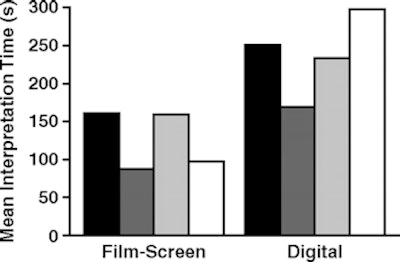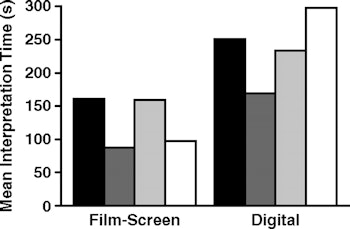
Digital mammography has proved equivalent to film-screen in screening programs for most women, along with being even more accurate than film-screen for women with dense breasts. But the technique can take longer to interpret, which can slow a practice's workflow and therefore affect its bottom line.
Researchers at the University of Texas M. D. Anderson Cancer Center in Houston compared interpretation speeds for digital and analog screening mammograms to determine whether other variables might affect the reading times for these scans and contribute to a difference in interpretation speed for the two technologies (American Journal of Roentgenology, January 2009, Vol. 192:1, pp. 216-220).
Dr. Tamara Miner Haygood, Ph.D., and colleagues timed four radiologists as they interpreted 457 total mammograms (268 digital and 189 film-screen). All four readers read both digital and analog mammograms, but not in the same session. The study began in April 2006 and ended in May 2007.
Readers used a Stentor version 3.3 workstation (Philips Healthcare, Andover, MA); film-screen mammograms were hung on a dedicated alternator (CrystalViewer, S&S X-Ray, Houston). The radiologists used an automated report-entering program (Mammography Information Management System, MagView, Burtonsville, MD) for both film-screen and digital mammograms.
At the time of the study, three of the four readers practiced breast imaging exclusively. The screening mammography case load for each in 2007 varied from 947 to 1,564, and the range of mammography interpretation experience for the four readers was one to 16 years. Experience in interpreting digital mammography was nine to 18 months.
The interpretation time included report entering because the participating radiologists shifted back and forth between reading and entering report data.
The study found the following mean interpretation times for the readers (in seconds).
|
The team found a difference of 129 seconds between the mean interpretation times of the fastest and slowest reader for digital and a difference of 76 seconds for analog.
 |
| Mean times of four radiologists for interpretation of film-screen and digital mammograms. Image courtesy of the American Roentgen Ray Society. |
Differences between the mean interpretation times for digital and film-screen mammograms ranged from 58 seconds for four-view exams to 144 seconds for BI-RADS category 0 exams.
Comparisons by groups
|
||||||||||||||||||||||||||||||||||||||||||||||||||||||||||||||||
| Unless otherwise specified, data are mean interpretation time in seconds. Table courtesy of the American Roentgen Ray Society. |
The need to select and hang films slowed interpretation, Haygood and colleagues found, as well as having more than four images in the study and BI-RADS category 0 interpretations.
The team pointed out that another factor that can slow digital reading time is how long it takes to segue from film comparison studies to digital. At M. D. Anderson Cancer Center, current films are compared with studies that are at least two years old; patients must have a minimum of two years after the acquisition of the first digital study before the film-screen studies are not included in the interpretation.
Digital equals double?
Digital mammography has financial advantages over film-screen, including decreased storage, handling, and film costs, and it streamlines the time needed for individual exams, the authors wrote. But it does take longer to interpret.
"The amount of difference varies from person to person, but a reasonable estimate is that interpretation time will nearly double for digital mammograms compared with film-screen mammograms," the team wrote.
And although the interpretation time for digital increases, the professional part of reimbursement does not. At the time of the study, Medicare reimbursement for digital mammogram interpretation was $34.26, and reimbursement for film-screen mammogram interpretation was $34.64.
"A radiologist who takes 180 seconds average per digital mammogram can read 20 digital mammograms in an hour and earn $685.20," the authors wrote. "A radiologist who takes 100 seconds average per film-screen mammogram can read 36 film-screen mammograms in an hour and earn $1,247.04."
Of course, Medicare reimbursement for the technical component for digital mammograms is twice as high as for film-screen, the authors pointed out, stating that the economics of screening mammography vary depending on geographic factors, payor mix, and individual reading speeds.
Haygood's team concluded that digital mammograms take longer to read than film-screen mammograms in screening mammography interpretation, and that even the exclusive use of digital comparison studies may not cause reading times to drop enough to best film-screen mammography reading times.
By Kate Madden Yee
AuntMinnie.com staff writer
January 6, 2009
Related Reading
Contrast variations prove main factor for breast cancer visibility, December 2, 2008
Pisano elected to IOM, October 16, 2008
DMIST: Women under 50 with dense breasts benefit from FFDM, January 29, 2008
RSNA studies delve deeper into DMIST results, December 14, 2006
More DMIST analysis supports FFDM in younger women, dense breasts, November 26, 2006
Copyright © 2009 AuntMinnie.com




















